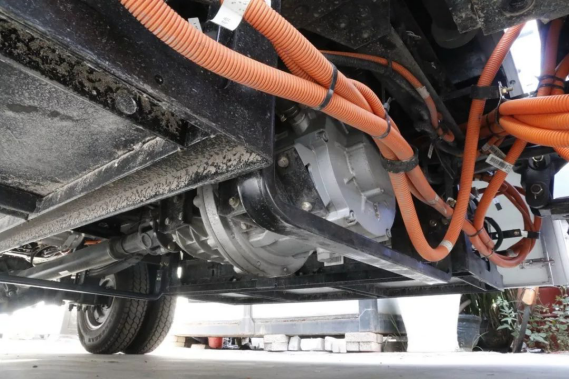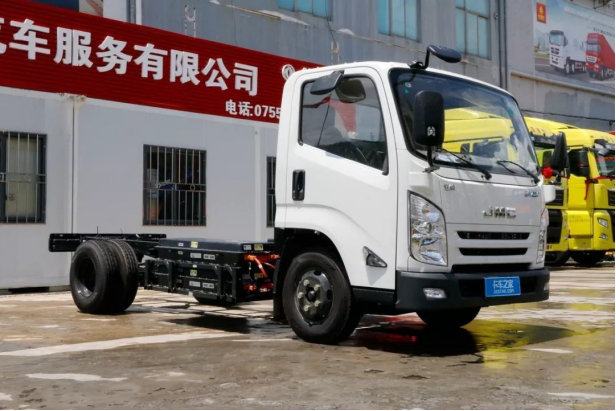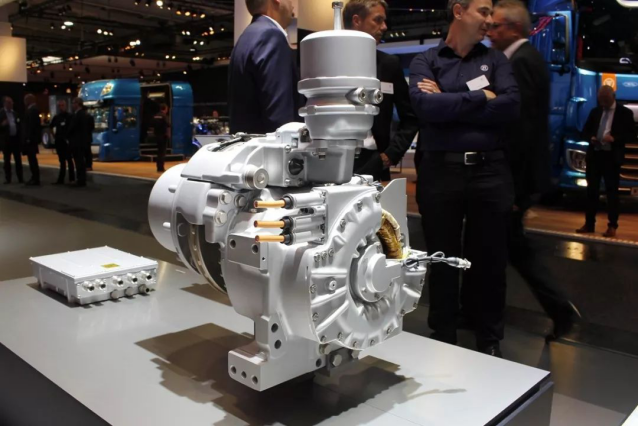The rapid development of the domestic logistics industry, the demand-driven delivery market, and the support of national policies have enabled new energy logistics vehicles to develop rapidly in recent years. In 2017, China's new energy special vehicle sales reached 150,000, a year-on-year increase of 152%. Among them, electric logistics vehicles are the main models, accounting for 97% of the total. Driven by local governments, e-commerce companies, and logistics companies, new energy logistics vehicles will usher in a blowout growth.
Pure electric logistics vehicle drive system
The rapid development of electric logistics vehicles has also driven the technical development of drive systems. According to data from well-known electric drive system manufacturers, there are currently three mainstream solutions for pure electric logistics vehicle drive systems:
Motor direct drive system of Jiangling electric light truck
(1) Motor direct drive: The advantage is that the transmission efficiency is very high, up to about 95%. Since the peak torque requirement of the motor on the logistics vehicle is long, the motor under this solution cannot reduce the cost by reducing the motor torque. Why can't the large torque reduce the cost? It will be mentioned later.

Motor + gearbox drive system for three-ring pure electric light truck
(2) Motor + reduction / gearbox drive: The electric drive system is equipped with a reduction / gearbox, which can greatly amplify the motor torque, so the torque of the motor is reduced, and the cost of the motor can be reduced by up to> 50%. In addition, the weight of the gearbox is much lower than that of the motor, so it also has certain advantages in terms of weight reduction. But in terms of transmission efficiency, it is not as good as a direct drive.

BYD's electric drive bridge
(3) Electric drive bridge: The advantage is that it eliminates the need to install suspension, drive shaft, three-phase lines, water pipes and other components in the power assembly, and the overall weight is lower than that of the gearbox.
Three factors to consider in electric vehicle drive systems
Three factors need to be considered in electric vehicle drive systems:

At present, the technical route of the pure electric logistics vehicle power system mainly considers three indicators: cost reduction, weight reduction, and efficiency improvement.
1. Cost reduction: In the post-subsidy era, the cost of pure electric vehicles is gradually approaching traditional fuel vehicles. The requirement for pure electric systems is that costs continue to fall significantly. The reduction of the cost of the motor mainly depends on the main internal parts of the motor. The cost of a commercial vehicle motor is almost directly proportional to the output torque of the motor. The larger the torque, the higher the cost. Therefore, the types of motors that require large torque and long duration, such as direct drive for commercial vehicle motors, are difficult to reduce.
2. Weight reduction: The increase in the weight of pure electric vehicles will increase the power consumption. The factors that determine the weight of the motor are still the internal components of the motor. The weight of the motor is also proportional to the torque. It is difficult to increase the torque density of the motor in a short period of time. It also means that if you want to reduce the weight of the motor by reducing the torque, only It can be equipped with a reduction / gearbox to use a lower torque motor or directly use an electric drive axle.
3. Efficiency improvement: The power system is the main energy-consuming component of pure electric vehicles. Increasing the efficiency of the power system is the key to increasing cruising range and reducing battery costs. At present, the comprehensive efficiency of the motor and the motor controller is about 95%, and the space for improvement is very limited. According to the data, if the efficiency of the main reducer is increased by 1%, the power consumption of the entire vehicle can be reduced by more than 2.5%.
Future trends of electric drive systems for electric logistics vehicles
Speeding up the motor:
With the improvement of the technical level of the motor, the speed index of the motor will gradually increase; under the same requirements of the dynamic performance, the torque of the motor can be further reduced, which leads to a reduction in cost and weight. This trend is already very obvious in the field of passenger cars, and also in the field of new energy logistics vehicles, high-speed motors are an inevitable trend.
Drive system integration:

ZF In-wheel Motor
At present, most motors, motor controllers, and reduction / transmissions of power systems are relatively independent components, which increases the layout space of the power system and the cost and weight of related accessories. With reference to the development trend of passenger cars, by eliminating the need for three-phase lines, water pipes and other accessories to further reduce costs and layout space, it will become the development trend of new energy logistics vehicles.
summary
From the current point of view, the direct drive solution has limited space for improvement in the future performance requirements of electric logistics vehicles. Therefore, it is predicted that in the new generation products of major manufacturers, the amount of direct drive of the high-end positioning products with assembled motors should be somewhat different. The reduction / transmission solution has advantages in terms of weight and cost, but also has limited efficiency improvement space, but it is expected that it will still be the mainstream electric power chain of 4.5 ton electric logistics vehicles in the future; the last electric drive axle solution will reduce costs It has obvious advantages in terms of weight, efficiency, and is almost suitable for models with a load of 2.5-18 tons. Therefore, in the powertrain technical route, the reduction / transmission and electric drive axle systems will gradually become the mainstream.





